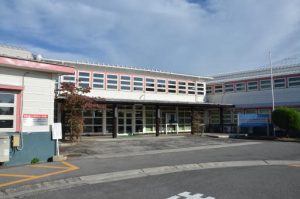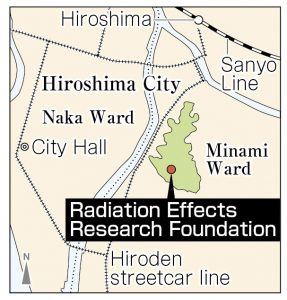RERF to digitize more than 10 million pages of paper documents—including A-bomb survivor medical records and physician notes
Jan. 23, 2020
(by Junji Akechi, Staff Writer)
Preparations underway for establishment of new division for centralized digital data management
The Radiation Effects Research Foundation (RERF), located in Hiroshima’s Minami Ward, is working to establish a new division at RERF called the Research Resource Center. The center will be designed to digitize and centrally manage the huge volume of documents and materials, such as medical records of A-bomb survivors, that RERF has collected from its studies over many years. By doing so, RERF will prevent any loss of the globally important materials and ensure their future use in research. Pilot work has already begun on the creation of a database, with the aim of firming the center operations sometime in fiscal 2021.
RERF continues to carry out its health studies of A-bomb survivors and second-generation survivors, with related paper documents—including survivors’ medical records, interview records, sketches of exposure circumstances at the time of the atomic bombing, and physicians’ notes—estimated to number about 10–15 million pages. If the documents continue to be stored as is, they are at risk in case of disasters, for example. The paper documents also make it hard for researchers to compare and analyze data.
RERF intends to pursue a policy of digitizing all the paper materials and creating a database of the resulting anonymized data. It will establish a system whereby researchers are able to readily utilize data for their research projects by enabling cross-sectional analysis based on information such as radiation exposure dose and disease history. In future, all information—including data stored by each research department as well as survivors’ blood samples and other biosample data—would be consolidated in the new center. Through utilization of the database, RERF hopes to increase the number of collaborative research projects conducted with other scientific institutes in the world as it strictly manages personal information.
For the time being, RERF is working on methods for scanning the huge volume of materials and organizing the database structure appropriate for its research. Starting in fiscal 2019, it has invited experts from the United States and initiated the pilot work. Within three years of fiscal 2019, details will be finalized and full-fledged operations of the center initiated. However, to digitize all the materials, at least a decade is thought to be necessary.
RERF first announced plans for establishment of the Research Resource Center in 2014 at its Scientific Advisory Committee, an outside body of leading scientists. Ever since, RERF has investigated examples of material digitization and utilization that have been used in Japan and other countries. Eric Grant, Associate Chief of Research at RERF, explained plans for the new center. ”We finally reached the pilot stage and now want to develop a system to ensure the protection of these globally important materials obtained with cooperation from the A-bomb survivors.” Dr. Grant added, “We hope to move ahead with utilization of the digitized materials for our research while receiving understanding from A-bomb survivors.”
Meanwhile, RERF is considering relocation because of its aging facilities and other reasons. A survey conducted by an outsourced company in fiscal 2018 concluded that moving RERF to Hiroshima City’s General Health Center in Naka Ward, a candidate relocation site proposed by the city, was “viable.”
Keywords
Radiation Effects Research Foundation (RERF)
With the aim of examining the long-term health effects of exposure to radiation from the atomic bombings, the Atomic Bomb Casualty Commission (ABCC), RERF’s predecessor organization, was founded in 1947. Later, based in Hiroshima and Nagasaki, ABCC began a study of about 120,000 A-bomb survivors. In 1975, ABCC was reorganized into RERF, which is jointly funded and managed by the governments of Japan and the United States. RERF has studied associations between A-bomb survivors’ radiation exposures at the time of the atomic bombings and subsequent cancer incidence and mortality rates. The research organization also continues studies of second-generation A-bomb survivors and in-utero survivors. Around the beginning of ABCC’s establishment, the organization endured criticism for prioritizing research of the A-bomb survivors over providing treatment. With that in mind, Ohtsura Niwa, chairman of RERF, expressed in 2017 his appreciation for the A-bomb survivors who have cooperated in RERF research, as well as his regret for the organization’s past behavior. “We take that criticism seriously and feel great remorse.”
(Originally published on January 23, 2020)
Preparations underway for establishment of new division for centralized digital data management
The Radiation Effects Research Foundation (RERF), located in Hiroshima’s Minami Ward, is working to establish a new division at RERF called the Research Resource Center. The center will be designed to digitize and centrally manage the huge volume of documents and materials, such as medical records of A-bomb survivors, that RERF has collected from its studies over many years. By doing so, RERF will prevent any loss of the globally important materials and ensure their future use in research. Pilot work has already begun on the creation of a database, with the aim of firming the center operations sometime in fiscal 2021.
RERF continues to carry out its health studies of A-bomb survivors and second-generation survivors, with related paper documents—including survivors’ medical records, interview records, sketches of exposure circumstances at the time of the atomic bombing, and physicians’ notes—estimated to number about 10–15 million pages. If the documents continue to be stored as is, they are at risk in case of disasters, for example. The paper documents also make it hard for researchers to compare and analyze data.
RERF intends to pursue a policy of digitizing all the paper materials and creating a database of the resulting anonymized data. It will establish a system whereby researchers are able to readily utilize data for their research projects by enabling cross-sectional analysis based on information such as radiation exposure dose and disease history. In future, all information—including data stored by each research department as well as survivors’ blood samples and other biosample data—would be consolidated in the new center. Through utilization of the database, RERF hopes to increase the number of collaborative research projects conducted with other scientific institutes in the world as it strictly manages personal information.
For the time being, RERF is working on methods for scanning the huge volume of materials and organizing the database structure appropriate for its research. Starting in fiscal 2019, it has invited experts from the United States and initiated the pilot work. Within three years of fiscal 2019, details will be finalized and full-fledged operations of the center initiated. However, to digitize all the materials, at least a decade is thought to be necessary.
RERF first announced plans for establishment of the Research Resource Center in 2014 at its Scientific Advisory Committee, an outside body of leading scientists. Ever since, RERF has investigated examples of material digitization and utilization that have been used in Japan and other countries. Eric Grant, Associate Chief of Research at RERF, explained plans for the new center. ”We finally reached the pilot stage and now want to develop a system to ensure the protection of these globally important materials obtained with cooperation from the A-bomb survivors.” Dr. Grant added, “We hope to move ahead with utilization of the digitized materials for our research while receiving understanding from A-bomb survivors.”
Meanwhile, RERF is considering relocation because of its aging facilities and other reasons. A survey conducted by an outsourced company in fiscal 2018 concluded that moving RERF to Hiroshima City’s General Health Center in Naka Ward, a candidate relocation site proposed by the city, was “viable.”
Keywords
Radiation Effects Research Foundation (RERF)
With the aim of examining the long-term health effects of exposure to radiation from the atomic bombings, the Atomic Bomb Casualty Commission (ABCC), RERF’s predecessor organization, was founded in 1947. Later, based in Hiroshima and Nagasaki, ABCC began a study of about 120,000 A-bomb survivors. In 1975, ABCC was reorganized into RERF, which is jointly funded and managed by the governments of Japan and the United States. RERF has studied associations between A-bomb survivors’ radiation exposures at the time of the atomic bombings and subsequent cancer incidence and mortality rates. The research organization also continues studies of second-generation A-bomb survivors and in-utero survivors. Around the beginning of ABCC’s establishment, the organization endured criticism for prioritizing research of the A-bomb survivors over providing treatment. With that in mind, Ohtsura Niwa, chairman of RERF, expressed in 2017 his appreciation for the A-bomb survivors who have cooperated in RERF research, as well as his regret for the organization’s past behavior. “We take that criticism seriously and feel great remorse.”
(Originally published on January 23, 2020)









